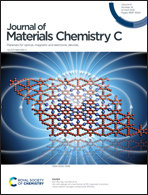Conduction transition and electronic conductivity enhancement of cesium azide by pressure-directed grain boundary engineering
Abstract
Alkali metal azides have attracted considerable experimental and theoretical efforts as they are the promising starting materials for the synthesis of polymeric nitrogen, a high-energy-density material. This work reports the conduction behavior of cesium azide (CsN3) under high-pressure using in situ impedance spectroscopy measurements. It is observed that pressure induces a transition from mixed ionic–electronic conduction to purely electronic conduction. The ionic to electronic transition was caused due to a sudden increase in the ionic migration barrier energy. Furthermore, grain boundaries were found to play a key role in the conduction process and served as high conductivity pathways for carrier transport at high pressures. The grain boundary effect improves the conductivity of CsN3 by more than two orders of magnitude after one pressure cycle. This work provides critical insight into the structure–conduction relationship of CsN3 and the role of grain boundaries in improving the conductivity of metal azides under high pressure.



 Please wait while we load your content...
Please wait while we load your content...